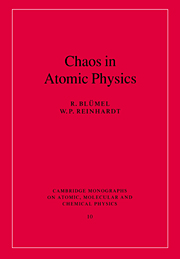Book contents
- Frontmatter
- Contents
- Preface
- 1 Introduction
- 2 Chaos: tools and concepts
- 3 Chaos in classical mechanics
- 4 Chaos in quantum mechanics
- 5 The kicked rotor: paradigm of chaos
- 6 Microwave-driven surface state electrons
- 7 The hydrogen atom in a strong microwave field
- 8 The kicked hydrogen atom
- 9 Chaotic scattering with CsI molecules
- 10 The helium atom
- 11 Chaos in atomic physics: state of the art and research directions
- References
- Index
7 - The hydrogen atom in a strong microwave field
Published online by Cambridge University Press: 14 September 2009
- Frontmatter
- Contents
- Preface
- 1 Introduction
- 2 Chaos: tools and concepts
- 3 Chaos in classical mechanics
- 4 Chaos in quantum mechanics
- 5 The kicked rotor: paradigm of chaos
- 6 Microwave-driven surface state electrons
- 7 The hydrogen atom in a strong microwave field
- 8 The kicked hydrogen atom
- 9 Chaotic scattering with CsI molecules
- 10 The helium atom
- 11 Chaos in atomic physics: state of the art and research directions
- References
- Index
Summary
The experimental investigation of chaos in atomic physics began with the historic experiment on microwave ionization of Rydberg atoms reported by Bayfield and Koch in 1974. The central result is the existence of an ionization threshold as a function of the microwave field. At the time (1974) this result was totally unexpected since ionization thresholds, in analogy to the photo-electric effect, were thought to appear only as a function of the frequency. Nowadays, especially in the light of the material presented in Chapters 5 and 6, the existence of an ionization threshold in the microwave field is less surprising and may be attributed to the existence of a critical microwave field that marks the onset of global chaos in the classical analogue of the Bayfield-Koch experiments. But at the time the Bayfield-Koch experiment was conducted, a connection with chaos was not suspected. Leopold and Percival (1978, 1979) were the first to investigate the Bayfield-Koch experiments using purely classical mechanics. This is allowed on the basis of the correspondence principle, Leopold and Percival argued, since the quantum numbers involved in the ionization experiments are large. This line of thought turned out to be very fruitful. With the help of Monte Carlo simulations of the time evolution of classical trajectories in phase space, Leopold and Percival were able to reproduce the existence and location of the microwave thresholds established by the Bayfield-Koch experiment.
- Type
- Chapter
- Information
- Chaos in Atomic Physics , pp. 181 - 202Publisher: Cambridge University PressPrint publication year: 1997

